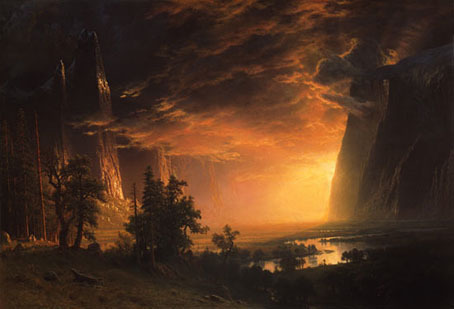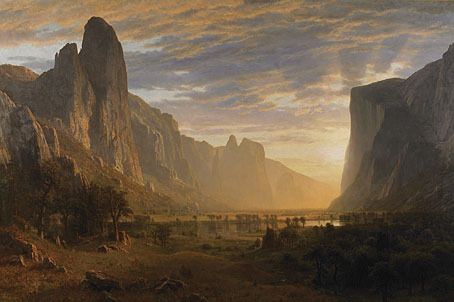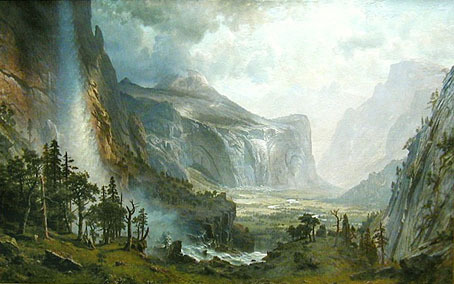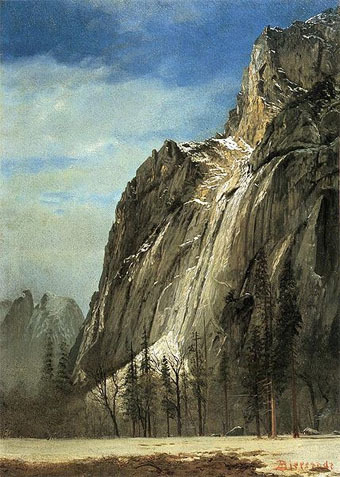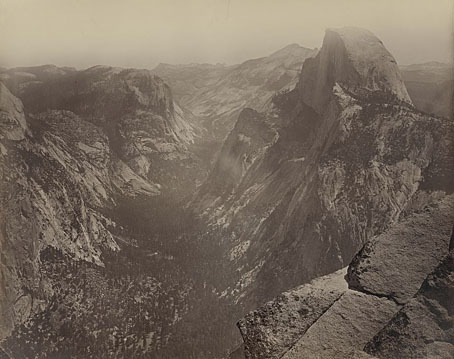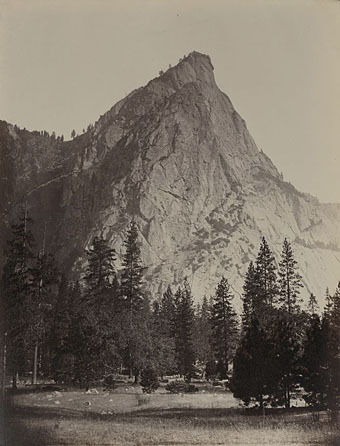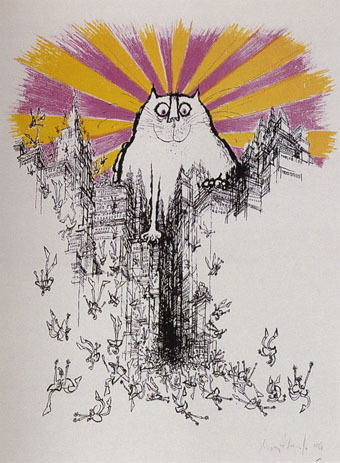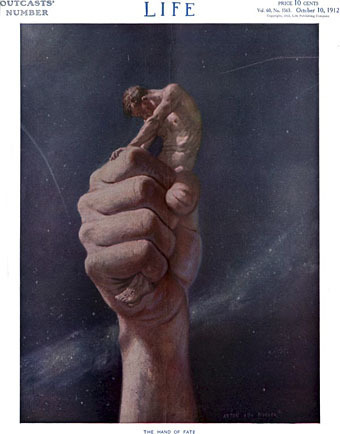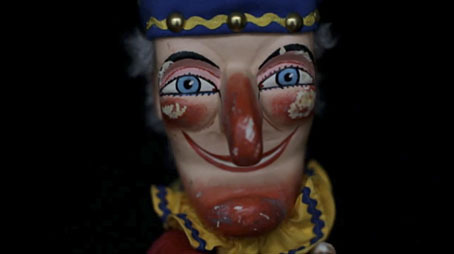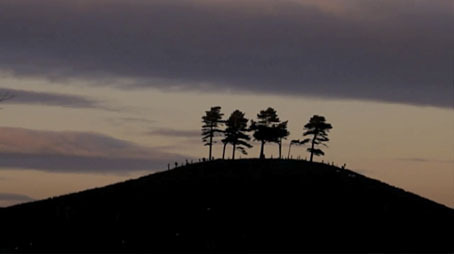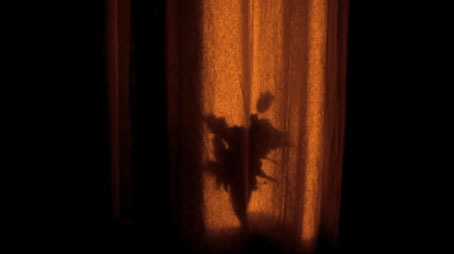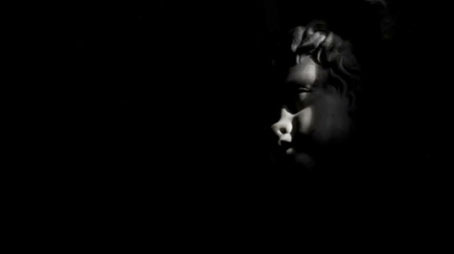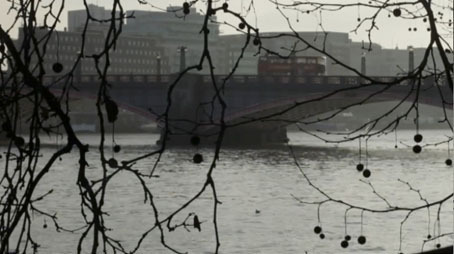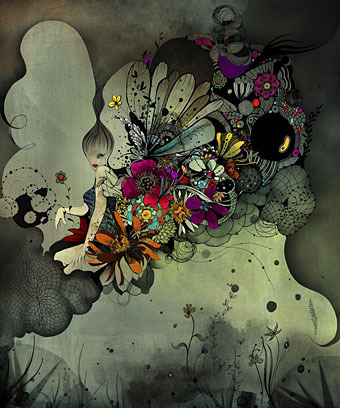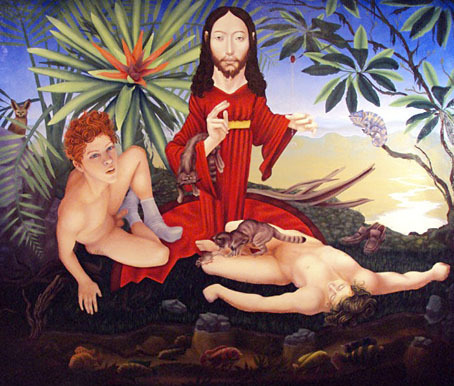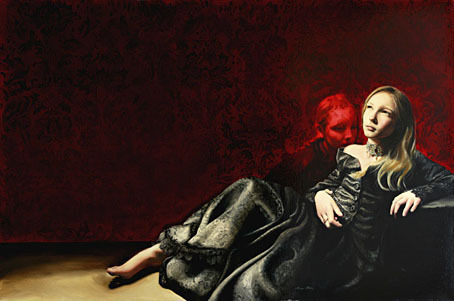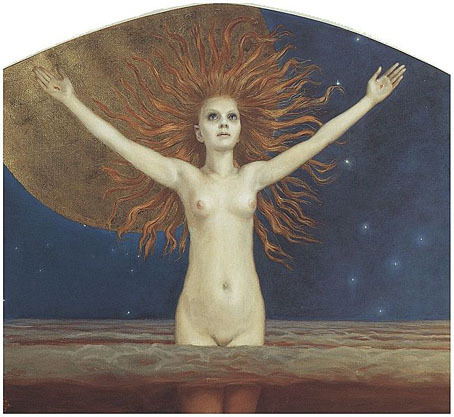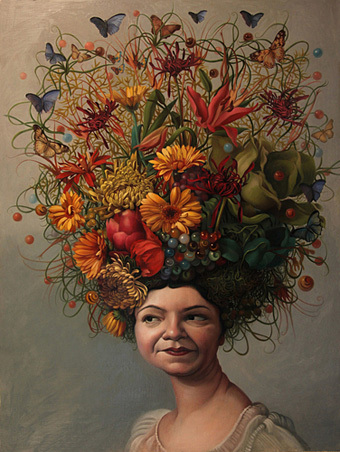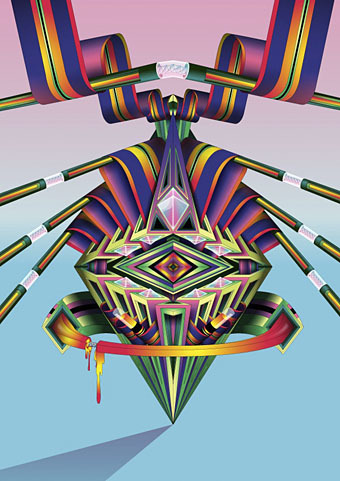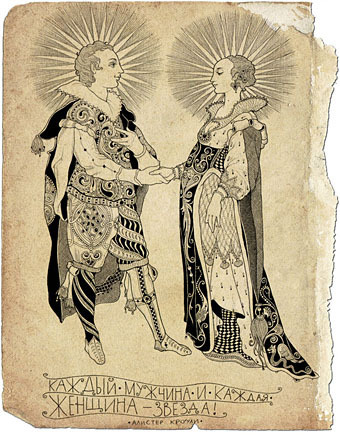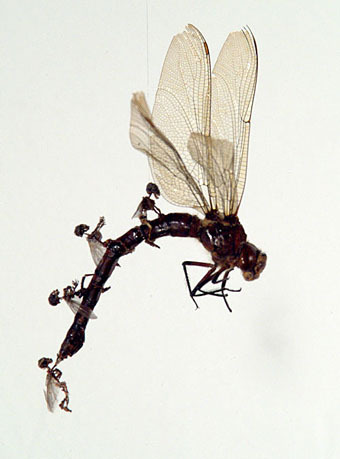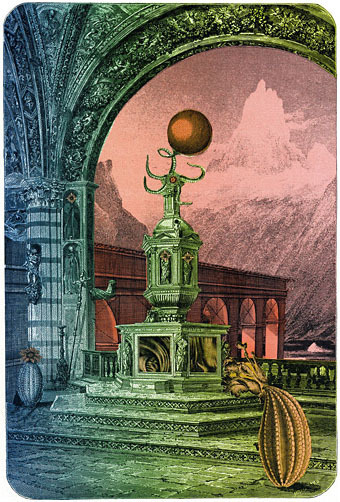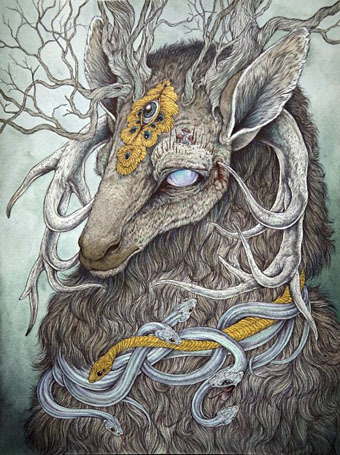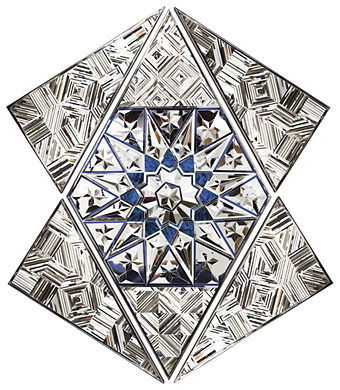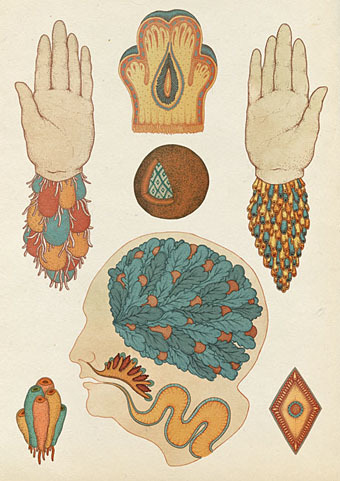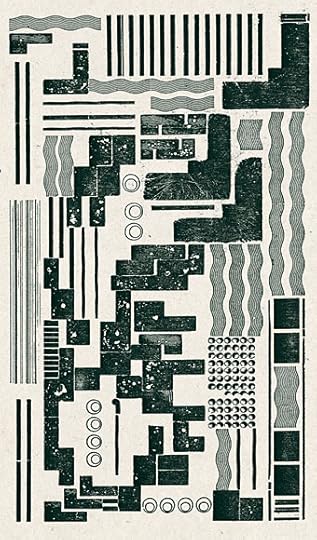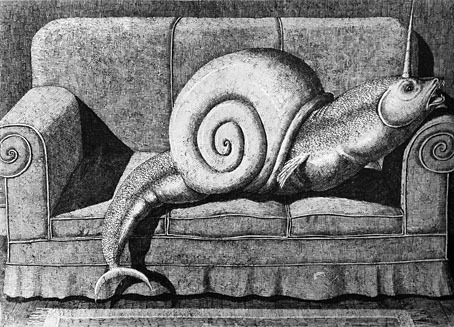John Coulthart's Blog, page 287
January 5, 2012
Albert Bierstadt in Yosemite
Sunset in the Yosemite Valley (c. 1868).
After yesterday's photos of the Yosemite Valley I have to follow up with paintings of the region by Albert Bierstadt (1830–1902), a German immigrant whose landscape art is connected to the Hudson River School although much of his work concerned views of California and the Rocky Mountains. Some of the paintings apparently received criticism for their deliberately Romantic approach to landscape, especially the John Martin-like blazing sunsets. All the pictures here date from the same period that Carelton Watkins was taking his celebrated photos of the area (which makes me wonder whether artist and photographer ever met) so complaints about lack of realism would seem somewhat redundant.
Wikimedia Commons has a substantial collection of Bierstadt's paintings.
Looking Down Yosemite Valley, California (1865).
The Domes of the Yosemite (1867).
Cathedral Rocks, A Yosemite View (1872).
Previously on { feuilleton }
• Carleton Watkins in Yosemite
• Two American paintings
January 4, 2012
Carleton Watkins in Yosemite
Yosemite Valley (c. 1865).
The Getty Museum recently published a large and expensive ($195) volume collecting all the surviving photographs by one of the pioneers of landscape photography, Carleton Watkins (1829–1916). The most important of Watkins' many photos of California in the mid-19th century are those taken in the Yosemite Valley, a series of views which helped persuade Abraham Lincoln to preserve the area as a national park. The pictures here are from where many of the images can be downloaded as huge (200mb) tiffs. The LoC also has a number of stereograph views. The quality of these pictures is quite stunning when you consider that the photographic medium was only about thirty years old. To capture many of these views Watkins had to cart a bulky glass-plate camera up and down mountain trails.
Carleton Watkins, The Complete Mammoth Photographs edited by Weston Naef & Christine Hult-Lewis can be ordered direct from the Getty Museum. There's also an earlier study by Weston Naef, Carleton Watkins in Yosemite.
Half Dome, Yosemite Valley (c. 1865).
Cathedral Rock, Yosemite Valley (c. 1865).
Front view, Three Brothers, Yosemite (c. 1865).
Previously on { feuilleton }
• Dead Roads
January 3, 2012
The art of Ronald Searle, 1920–2012
Undertakers. From Punch magazine (undated).
I started trying to draw like Ronald Searle when I was about eight. So there was Jabberwocky and Ronald Searle I was turning into by the time I was thirteen. You know, I was determined to be Lewis Carroll (giggles) with a hint of Ronald Searle.
John Lennon, 1968
Does the late Ronald Searle need any introduction? Everyone knows he created the anarchic schoolgirls of St Trinian's in the 1940s, although their exploits had the greatest audience in the films based on Searle's cartoons rather than the original drawings. Searle's work first came to my attention through reprints of the Molesworth books he produced with Geoffrey Willans in the 1950s—Down with Skool! (1953), How to be Topp (1954), Whizz for Atomms (1956) and Back in the Jug Agane (1959)—a masculine riposte to St Trinian's which allowed for a broader range of humour than the slapstick and short-skirted salaciousness the films drifted into. The Molesworth books are perhaps best appreciated at age 11 as this LRB review notes; looked at with older eyes all I see is a portrait of a rigidly class-bound nation whose boarding schools, gowned masters, "maters" and "paters" could only inspire affection in the Etonians currently attempting to govern Britain. But the drawings remain a treat: wiry and mordant with flashes of a viciousness that make Searle the godfather of Gerald Scarfe and Ralph Steadman.
The girls of St Trinian's, Lilliput magazine, December 1949.
Given Searle's influence on generations of newspaper cartoonists it's no surprise that the British papers are being free with the plaudits. Links to various stories follow. The images here are taken from earlier posts or pulled from my bookshelves. The illustration of Engelbrecht below is from the Savoy Books edition of Maurice Richardson's The Exploits of Engelbrecht which I designed in 2010.
• Guardian obituary | Telegraph obituary
• Ronald Searle in pictures: Telegraph | Guardian
• Ronald Searle: a life in pictures by Steve Bell.
• Mike Leigh: 'Ronald Searle was my inspiration'.
• Ronald Searle: Now let's have some fizz: Gerald Scarfe remembers his friend and childhood hero.
• Ronald Searle was our greatest cartoonist – and he sent me his pens, says Martin Rowson.
Other links:
• Perpetua, the Ronald Searle tribute
• Searle at VTS
• Winespeak at BibliOdyssey
Engelbrecht versus Grandfather Clock. From The Exploits of Engelbrecht (1950) by Maurice Richardson.
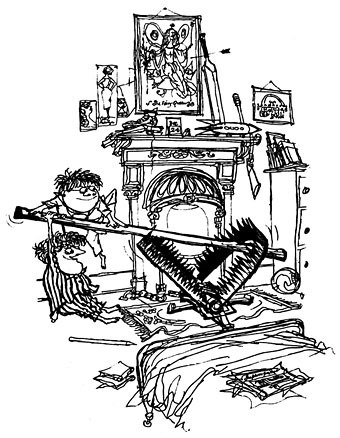
"A trap for dere Santa". From How to be Topp (1954) by Geoffrey Willans and Ronald Searle.
The Coming of the Great Cat God (1968).
Elsewhere on { feuilleton }
• The illustrators archive
Previously on { feuilleton }
• Engelbrecht lives to fight another day
• Ronald Searle book covers
• Engelbrecht again
January 2, 2012
Lunation: Art on the Moon
Image by Noah Doely.
Steve Moore's lunarian occult novel Somnium was published a couple of months ago, and now we have an art exhibition exploring similar themes. Lunation: Art on the Moon is a group show at Observatory, Brooklyn, NYC which opens on January 7th:
Artists portray the moon as a source of danger and power, and latter-day sorceresses and men of magic call up to that heavenly lamp, seeking to transcend the ordinary night. For them, the old myths have not changed so much: the moon is still a secret mirror, showing in pale light how the familiar contains always an element of the unexpected…
Participants include Grace Baxter, Jesse Bransford, Susan Crawford, Noah Doely, Joanna Ebenstein, Theo Ellsworth, Michelle Enemark, Ted Enik, Jesse Gelaznik, Ethan Gould, Dr. Gary Greenberg, Pam Grossman, Maria Liebana, Gerald Marks, Chad Merritt, Heidi Neilson, G.F. Newland, Rebeca Olguín, Kathryn Pierce, Lado Pochkhua, Dylan Thuras, Binky Walker, James Walsh and Julianne Zaleta.
Lunation: Art on the Moon runs to the end of February, 2012.

The Lake at Night by Jesse Gelaznik (2011).

Salvio Hexia by Chad Merritt (2011).
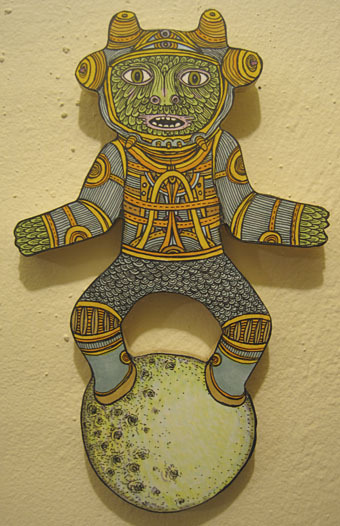
A gigantic space-man has landed on the moon, but why?! by Theo Ellsworth (2011).

Luna by Jesse Bransford (2009).
Previously on { feuilleton }
• Somnium by Steve Moore
• Blood on the Moon
• Filippo Morghen's Voyage to the Moon
January 1, 2012
Cthulhu for sale
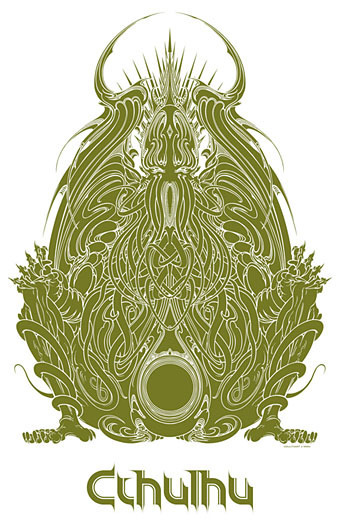
As promised last month, my latest piece of Cthulhu art has spawned itself over a range of CafePress products including posters, cards, T-shirts and CafePress's recent line of iPod/iPad cases. For the latter items and the apparel I've used the simpler version of the drawing above. See the artwork larger size here.
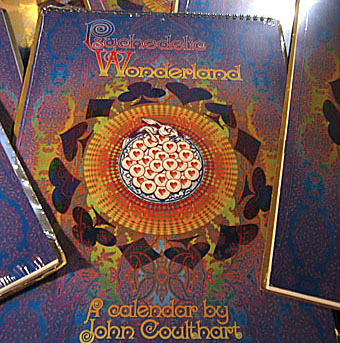
And it's customary at the beginning of January to reduce the Coulthart calendars to a dollar above their base price. Psychedelic Wonderland and Through the Psychedelic Looking-Glass for 2012 can now be had for $17.99/£13.50/€16.00 each. My thanks to everyone who bought copies before Christmas.
Previously on { feuilleton }
• Cthulhu God
• Cthulhu under glass
• CthulhuPress
• Cubist Cthulhu
December 31, 2011
Weekend links: 2012 edition
The Hand of Fate, Life magazine, October, 1912. Artist unknown.
• In Search of Barney Bubbles: the great graphic designer is profiled on BBC Radio 4, Monday, 2nd January. And speaking of album cover designers, Cool Hunting talked to Storm Thorgerson about his work.
• FACT mix 310 is a hugely eclectic two-parter from Moon Wiring Club. Grab it while it's still available. And there's also Solstmas 2011/2: The Final Countdown, a mix by El Minko Misterioso.
• One of the music events of the new year will be the release of Captain Beefheart's Bat Chain Puller album. Pre-order it here.
In 1972, at the age of thirty-one, [Fred] Halsted released L.A. Plays Itself, a film which drew upon Kenneth Anger's surrealist eroto-expressionism, and went way beyond Anger's sublimated homoeroticism to explicitly portray gay male S/M sex. In 1969, when Halsted first decided to make a sexually explicit film, he decided to create a part for himself, and then be that part.
Halsted Plays Himself by William E. Jones reviewed at Lambda Literary
• Lunar Rover: An interview with Steve Moore and extract from Somnium.
• Battersea Power Station, a graveyard of architectural schemes.
Editors might admire a fine book, but are overridden by marketing and accounting departments who now have the final say. I know of a novel that wasn't accepted by one publisher after the manuscript was first submitted to W.H. Smith, who said that it wouldn't sell enough.
Jenny Diski on the state of fiction publishing in the UK
• EU copyright on James Joyce's works ended at midnight.
• Dressed to Kill: Dispelling the Myths of Men in Drag.
• The Geology of the Mountains of Madness
• The Floppy Boot Stomp (1978 mix) by Captain Beefheart and the Magic Band.
December 30, 2011
Let England Shake
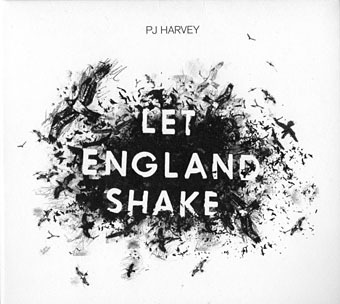
Design by Michelle Henning, drawings by PJ Harvey.
An album that's been a continual visitor to the Coulthart CD player over the past few months, Let England Shake was consciously composed like George Crumb's Black Angels "in time of war", referencing not only wars present but those long past. Coiled around the bellicose theme is a portrait of a nation whose patriotism is built on sand. England did shake this year, and the unavoidable correlation of PJ Harvey's words with the events of the summer makes her album stand in relation to 2011 the way The Specials' Ghost Town did to 1981.
In addition to the CD, Let England Shake also comes as a DVD of a dozen short films by photographer Seamus Murphy, one film for each song. Harvey and Murphy have very generously put the full set on YouTube in HD. Follow the links below.
December 29, 2011
The weekend artists
Flower Me Gently (2010) by Linn Olofsdotter.
Yes, this is one of those lazy end-of-year retrospectives, a look back at all the artists whose work was highlighted in the weekend posts for 2011. Thanks to BibliOdyssey, Form is Void and 50 Watts for so often pointing the way.
Blasphemous Rumours (2009/2010) by Ryan Martin. The artist now has a dedicated site for his paintings.
DG-2499 (1975) by the fantastic (in every sense of the word) Zdzislaw Beksinski (1929–2005). See the Dmochowski Gallery for a comprehensive collection of the artist's work.
Star City by Tomislav Ceranic.
Invisible Light by Margo Selski.
Three Seekers (2009) by Kelly Louise Judd.
From the Ornamental Age series (2009) by Seher Shah.
Ad Astra (1907) by Akseli Gallen-Kallela.
Oya by Alberto del Pozo (1945–1992). Also known as Yansa, Oya is Changó's third wife. She is the goddess of the winds and of lightning and is mistress of the cemetery gates. Passionate and brave she fights by her husband's side if needed. Her favorite offerings are papaya, eggplant and geraniums. From Santeria at BibliOdyssey.
Marbles and Butterflies (2011) by Jennifer Knaus.
A plate from Tales of the Amur by Dmitry Nagishkin, a 1975 edition illustrated by Gennady Pavlishin.
From Light Beyond Sound, a new series of works by Tatiana Plakhova.
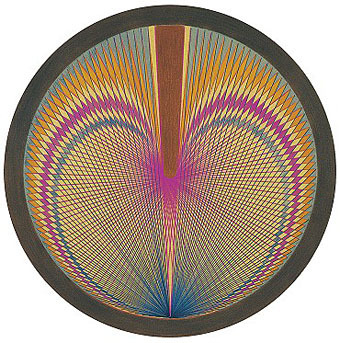
A design by Emma Kunz (1892–1963).
Neutron Drip (2011) by Amrei Hofstätter.
Every man and every woman is a star by Sveta Dorosheva.
Peacock Apocalypse (detail) by Julie Evans in collaboration with Ajay Sharma.
Manuel Orazi (1860–1934) was one of the best of the many Mucha imitators. An untitled & undated posting at Indigo Asmodel.
Eternal Pain (1913) by Paul Dardé. (And also here)
Art by Tessa Farmer.
Struggle (2009) by Lindsey Carr.
Black Cat on a Chair (1850–1860) by Andrew L Von Wittkamp.
At the Mountains of Madness (1979) from Halloween in Arkham by Harry O. Morris.
In Memory by Caitlin Hackett who describes her astonishing drawings as "contemporary mythology".
Regeneration (2011) by Toshiyuki Enoki.
Group I (Convertible Series, 2010) by Monir Farmanfarmaian.

Salammbô by Alastair (Hans Henning Voight) from Harry Crosby's Red Skeletons (1927). Dover published a new collection of Alastair's drawings in September.
Untitled art by Katie Scott.
Typographic Composition (1924) by Teresa Zarnowerówna from a post about Polish graphic design at 50 Watts.
A drawing from Bestiario Moderno by Domenico Gnoli (1933–1970).
December 28, 2011
Harry Clarke and the Elixir of Life
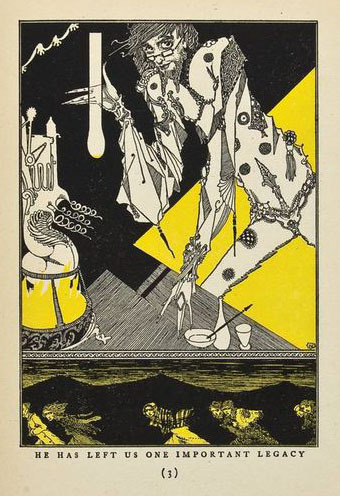
A little something for the season of strong drink. Harry Clarke's books command high prices in their original editions yet two of the costliest items in the Clarke bibliography are a pair of promotional booklets the artist illustrated for Jameson & Son's Irish Whiskey: A History of a Great House in 1924, and Elixir of Life a year later. Given the quality of Clarke's work for these publications it's a shame they remain out of print; I'm sure I'm not the only Clarkeophile who'd be happy to buy a facsimile edition.
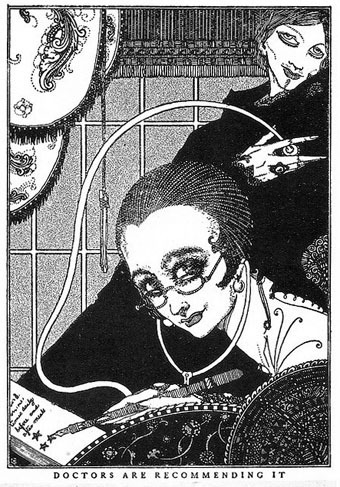
Elsewhere on { feuilleton }
• The illustrators archive
Previously on { feuilleton }
• Cardwell Higgins versus Harry Clarke
• Modern book illustrators, 1914
• Illustrating Poe #3: Harry Clarke
• Strangest Genius: The Stained Glass of Harry Clarke
• Harry Clarke's stained glass
• Harry Clarke's The Year's at the Spring
• The art of Harry Clarke, 1889–1931
December 23, 2011
Richard Williams' Christmas Carol
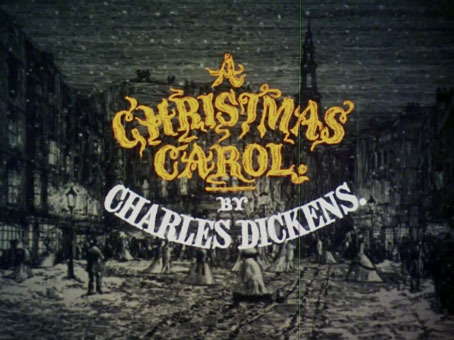
It's easy to loathe the teeth-grinding sentimentality of Charles Dickens' seasonal tale, as well as its subtext which isn't so far removed from Emperor Ming's instruction to his cowed populace in Flash Gordon: "All creatures shall make merry…under pain of death." Yet as a ghost story I prefer A Christmas Carol to the sketchier The Signal-Man, and I've always enjoyed this memorable 1971 adaptation from the animation studio of the great Richard Williams.
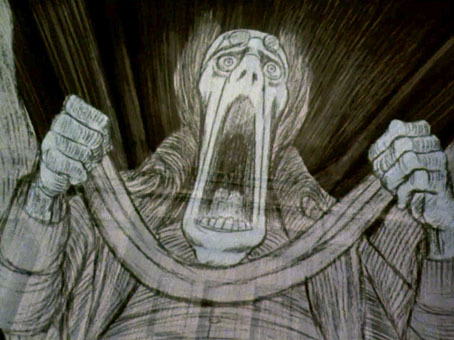
Marley's ghost.
Williams is best known today for his role as animation director on Who Framed Roger Rabbit? but prior to this he'd distinguished himself as creator of the florid title sequence for What's New, Pussycat? (1965), and the animated sections—done in the style of 19th-century engravings and political cartoons—for Tony Richardson's The Charge of the Light Brigade (1968). Williams' Christmas Carol owes a similar debt to Victorian graphics, not only to the original story illustrations by John Leech, but also to Gustave Doré's views of Victorian London, scenes which had earlier influenced the production design for David Lean's adaptation of Oliver Twist. Williams' film crams Dickens' story into 25 minutes but nonetheless manages to maintain the tone of the original to a degree which eludes many feature-length travesties, especially those in which the nightmare squalor of Victorian London is reduced to a shot or two of dressed-down extras. Dickens had first-hand experience of the squalor: Kellow Chesney's The Victorian Underworld (1970) quotes at length from one of the journeys Dickens took (under police escort) through the notorious St Giles rookery, and his ghost story was intended as much as a warning to the complacency of middle-class Victorian readers as a Christmas celebration.
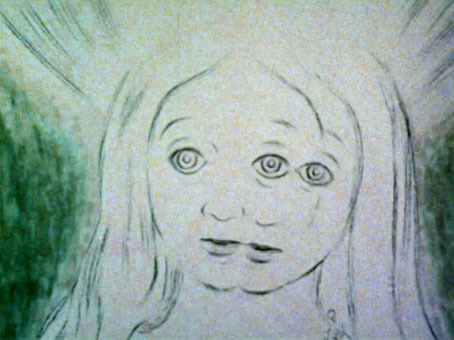
The Ghost of Christmas Past.
For me the crucial moment in any adaptation comes when the Ghost of Christmas Present shows Scrooge the figures of Ignorance and Want: in most film versions these tend to be a pair of well-fed child actors in rags and make-up; Williams shows us two grim spectres that owe more to Gerald Scarfe than Walt Disney. Williams is also truer to the ghosts themselves: Dickens describes Jacob Marley unfastening his jaw which falls open then remains that way while he proceeds to speak to his former friend; the Ghost of Christmas Past is the androgynous figure from the story with its ambiguous nature also shown by its shimmering indeterminate outline.
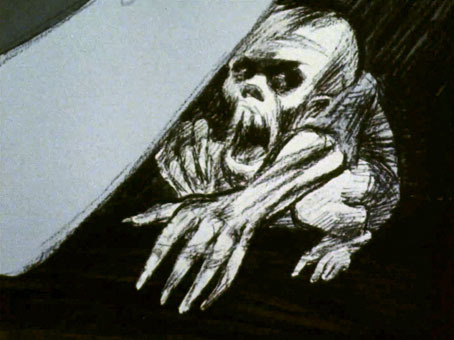
Ignorance.
Any animated drama relies on its voice actors, and Williams was fortunate to have Alistair Sim (as Scrooge) and Michael Hordern (as Marley) reprising their roles from the 1951 film version, while Michael Redgrave narrates the tale. The film used to be a seasonal fixture of British television, and may still be for all I know (I haven't owned a TV for years). For the time being it's on YouTube, of course, with a full-length version here that's blighted by compression artefacts but is watchable enough. 2012 is the Dickens bicentenary so expect to hear a lot more about the author and his works in the coming year.
As usual I'll be away for a few days so the { feuilleton } archive feature will be activated to summon posts from the past below this. Have a good one. And Gruß vom Krampus!
Previously on { feuilleton }
• "Who is this who is coming?"
John Coulthart's Blog
- John Coulthart's profile
- 31 followers


